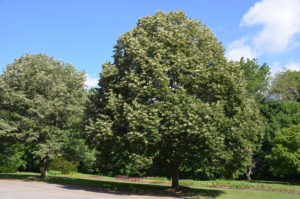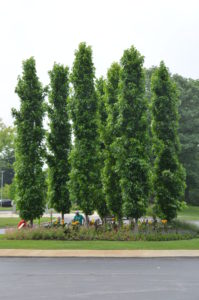Maintaining good plant nutrition is of key importance. A tree and shrub which is growing vigorously can resist infestation from most diseases and insects. Symptoms of poor nutrition: pale green or chlorotic leaves; undersized plants; slower annual growth rate; many dead or dying branch tips; increased insect/disease problems.
Trees under 10 years of age should be fertilized annually. There is little need to feed newly planted specimens and those suffering root damage from recent trenching or construction. Yard shade trees generally receive adequate fertilizing if the lawn is fed twice annually. Old established trees do not need to be fertilized every year.
High pH (alkaline) soils can result in chronic deficiencies of nutrients in some tree species, such as red maple, birch and pin oak, as well as nitrogen-deficient soils. Nitrogen (N), phosphorus (P), and potassium (K) are essential plant nutrients found in bags of fertilizers. The analysis will vary from one fertilizer manufacturer to another. Some products may be organic-based and are “slow-release”.
The fertilizer label on the package lists the exact proportions of available nutrients. For example, a bag label of 20-10-10 contains 20% N, 10% P (phosphoric acid), and 10% potassium (K) as potash. A 50 pound bag containing 20% nitrogen fertilizer (10 pounds of actual nitrogen) and also 5 pounds each of P and K.
Your soil should be tested every 4-5 years to check and correct (if necessary) a nutrient deficiency or soil pH that may be out of balance. Many land grant universities and full service garden centers offer fee-based soil testing.
General Fertilizer Program for trees and shrubs:
Here in Tennessee or Virginia, the best time to fertilize is late March or early April or in late fall once plants are dormant. In New England or Midwestern states, application time may be 2-4 weeks later. Weigh out the recommended fertilizer and distribute it evenly under the tree or around the shrub. Do not fertilize within 12 inches of the main trunk. Do not exceed rate of 3 lbs. of actual nitrogen per 1,000 square feet. Tree roots usually spread 1.5 times the diameter of the branch spread or that of the shrub width. Around mass groupings of plants, calculate the surface area around the entire planting to be fertilized (see photos above).
Information Source: Morton Arboretum in Lisle IL



 Posted in
Posted in 
